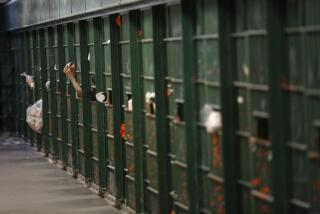Spain Acts Against Prisons Becoming Militant Hotbeds
- Share via
MADRID — The discovery of a new cell of Islamic militants who met in prison and planned to assassinate the judges investigating them has exposed Spain’s crowded penal system as a breeding ground for terrorists, officials say.
Alarmed that prisons have become a center for hatching plots, the government last week ordered hundreds of inmates to be transferred or isolated as part of a range of measures aimed at separating suspected and convicted Muslim extremists and preventing them from recruiting new allies, authorities said.
Mercedes Gallizo, general director of the country’s penal system, said wardens and guards would be instructed to monitor foreign-born prisoners more closely.
The crackdown comes after a government investigative committee announced that the leader of the recently discovered cell had met and recruited his associates during two stints in a Salamanca prison from June 2000 to June 2002.
The suspect, Mohammed Achraf, an Algerian, is currently in jail in Switzerland but was named last month by Spanish Judge Baltasar Garzon as the ringleader of a plot to blow up Madrid’s National Court building with a truck carrying more than 1,000 pounds of explosives. Spain is seeking his extradition.
Garzon filed terrorism charges against 17 other suspects -- one Spaniard and 16 Moroccans and Algerians -- in connection with the alleged plot. Several had spent time in the Salamanca prison, mostly for common crimes such as theft.
There are approximately 7,000 Muslims -- the vast majority of them immigrants -- in Spain’s 77 jails and prisons, roughly 12% of the penal population. Only 73 are terrorism-related incarcerations.
“We observed a radical change in Muslim prisoners after Sept. 11,” 2001, said Juan Figueroa, vice president of the prison employees union.
“After Sept. 11, the inmates radicalized,” Figueroa said. “Groups of hard-core Muslims began to form, and they pressured other Muslims.”
Since 1999, Figueroa said, six out of 10 new prisoners processed into the penal system have been foreigners.
Brawls in the Salamanca prison between Spanish and Muslim immigrant inmates in 2001 and 2002 led to the formation of a group called Martyrs for Morocco, government officials said.
The group, under Achraf’s leadership, is said to be responsible for the plan to bomb the court building.
Judicial investigators believe that planning for the strike on the court began two years ago in the prison, long before Spain’s deadliest terrorist attack -- the March 11 bombings of three commuter trains that killed nearly 200 people.
Figueroa, whose organization has been warning officials of the growing problem of radicalization in the prisons, described what he called the paramilitary structure of hard-core groups.
Typically, he said, a Muslim clique would look to an imam or spiritual leader among them, whose authority is enforced by one or two “colonels,” who oblige all Muslims in the cellblock to comply with Islamic rules.
The majority of Muslim inmates, he said, are poor and illiterate. Most are incarcerated for common crimes.
“It’s an easy breeding ground,” he said.
The new measures ordered in the prisons raise civil rights concerns, since inmates could be separated, isolated or punished on the basis of suspicion rather than concrete wrongdoing.
Officials, however, said they would respect religious freedom and civil rights, and noted that separating imprisoned Basque separatists had succeeded in weakening their main group, ETA.
In addition to Achraf and the 17 others charged in the court bombing plot, judicial officials last week announced the arrest of 13 more terrorism suspects, all from Morocco or Algeria.
The National Court, where terrorism suspects are tried, also houses the offices and archives of Garzon and other leading judges who are investigating the March 11 attacks and are conducting a separate, longer probe into Al Qaeda activities in Spain.
Special correspondent Cristina Mateo-Yanguas contributed to this report.
More to Read
Sign up for Essential California
The most important California stories and recommendations in your inbox every morning.
You may occasionally receive promotional content from the Los Angeles Times.














